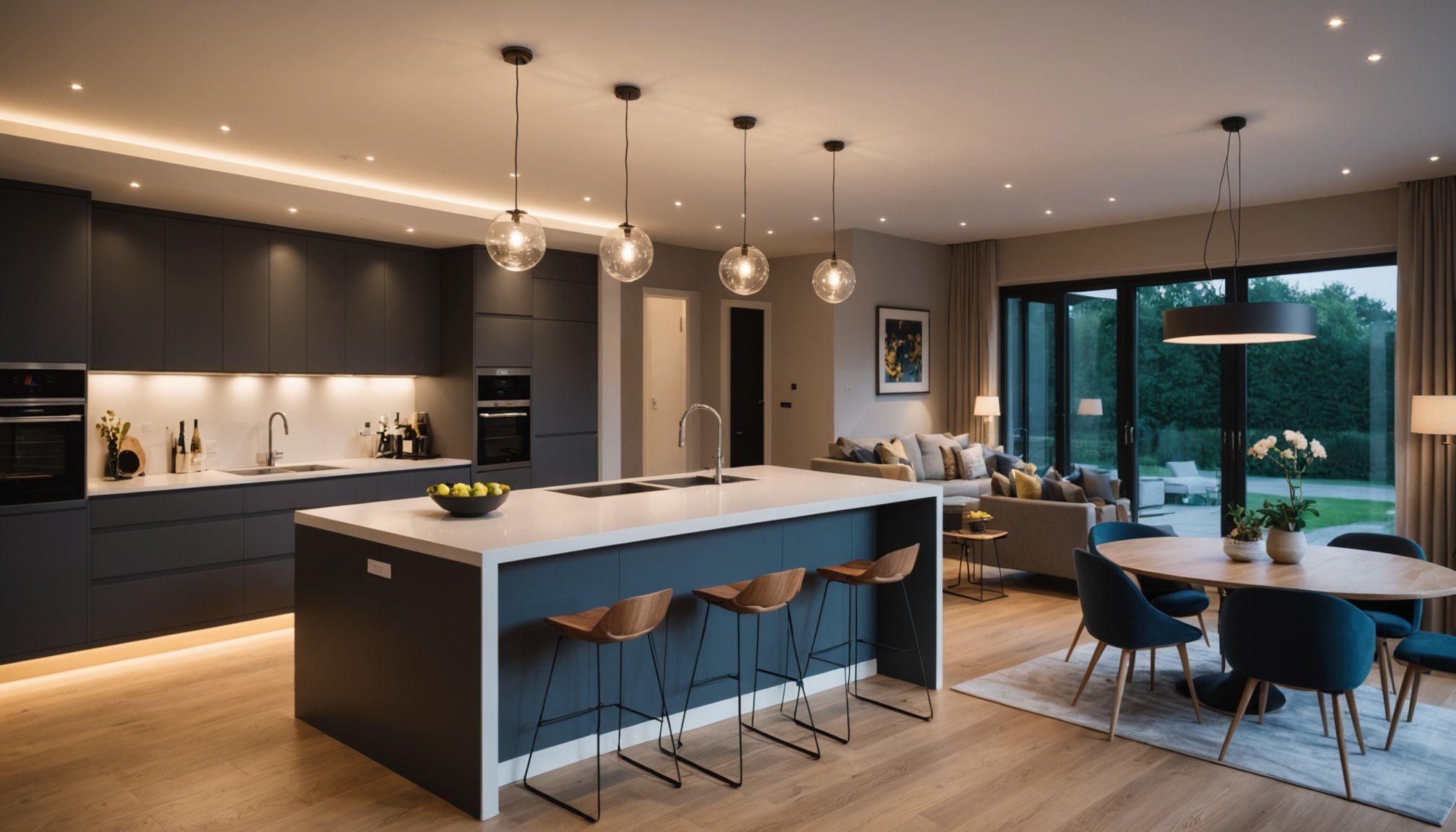Benefits of Smart Lighting in UK Homes
Smart lighting offers several compelling advantages for UK homeowners. One of the most notable is energy efficiency, which significantly contributes to cost savings. Smart lighting systems, equipped with sensors and timers, allow homeowners to optimise their energy usage by turning lights off when not needed. This can lead to substantial reductions in electricity bills over time.
In terms of convenience, smart lighting systems are seamlessly integrated into home automation features. With the use of mobile apps or voice commands, residents can control lights remotely, schedule them to match daily routines, or adjust them to different settings without manual switches. This enhanced control adds a layer of ease and sophistication to daily life.
Also to see : Best insulated lunch bags for keeping meals hot while traveling
Moreover, smart lighting enhances a home’s aesthetics and ambiance. Whether it’s a cosy living room setting or a vibrant garden party, smart lighting can create the ideal atmosphere. Adjustable colour temperatures and intensity settings offer a versatile solution that can transform and uplift any space’s mood, making them not only functional but also an integral part of modern interior design. These benefits make smart lighting a forward-thinking choice for anyone looking to modernise their home environment effectively.
Types of Smart Lighting Options
In the world of modern illumination, there are numerous types of smart lighting options that cater to diverse needs and settings.
Additional reading : Strategic CO2 Detector Placement: A Guide for UK Terraced Homes
Smart Light Bulbs
Smart light bulbs are an entry point into the future of lighting technology. Offering flexibility and ease of installation, these bulbs can be controlled wirelessly, often through smartphone apps or voice commands. They come in color changing lights options, allowing users to switch between millions of hues. Enjoy customised scenes for any mood or activity, such as relaxing evenings or energising mornings with just a tap or voice command.
Smart Switches
For those not wanting to replace individual bulbs, smart switches provide an efficient solution. They function by integrating with existing light fixtures, giving you centralised control over entire rooms. Smart switches also offer schedule setting and remote operation, making them a preferable choice for smart home enthusiasts.
LED Strip Lights
LED strip lights add versatility and creativity to any environment. Ideal for accent lighting, they enhance ambience whether placed under cabinets or behind TVs. These strips often feature LED integrations that allow synchronization with music or media content, creating immersive experiences. With a range of vibrant colours and varying brightness levels, LED strip lights elevate any space to a new dimension of elegance and technology.
Compatibility with Existing Home Systems
Navigating the smart home compatibility landscape can seem daunting, but understanding the fundamentals is key to seamless integration. Leading platforms like Amazon Alexa and Google Home offer broad integration with devices, enhancing the functionality and convenience of your home. Deciding which system to integrate with largely depends on the existing technology in your household and personal preferences.
Before diving into home automation, a critical step is to evaluate your home’s wiring and electrical systems. These are integral for ensuring any new smart devices will work efficiently without hiccups. Compatibility isn’t solely about devices and platforms, though. It’s also about infrastructure—specifically, your home network requirements. A strong Wi-Fi connection and network stability are pivotal for the success of your home’s automation ecosystem. It’s crucial to ensure your router is up to the task of handling multiple devices simultaneously.
Furthermore, homeowners should consider whether certain devices or technologies may require additional hardware or software updates to achieve optimal integration. This preparatory step minimizes the risk of connectivity issues, ensuring a smoother and more reliable smart home experience. Harnessing the potential of your connected devices starts with robust planning and integration assessments.
Installation Tips for Smart Lighting
Embarking on a DIY installation of smart lighting can save you money and offer a rewarding experience. Start by ensuring you have a compatible smart home hub. Most systems tie into existing wiring, so identify which rooms need new fixtures. For a smoother process, turn off the power at the circuit breaker before detaching current fixtures. Follow the manufacturer’s instructions to pair new smart bulbs with your hub using your smartphone app.
When should you consider professional installation? If you’re dealing with complex setups or desire a seamlessly integrated system, experts can ensure everything functions flawlessly. They can also provide guidance on optimal bulb placement and integration with other smart home devices.
Avoid these common pitfalls for a successful installation:
- Neglecting compatibility checks could result in system failures.
- Failing to update your smart home app may lead to connectivity issues.
- Overloading circuits can be unsafe; consult an electrician if in doubt.
Remember, safety is paramount. If you’re hesitant or run into trouble, don’t hesitate to call in a professional. With the right approach, your home will glow with the vibrant touch of smart lighting, offering convenience and control at your fingertips.
Cost Considerations for Smart Lighting Integration
When considering smart lighting costs, it’s crucial to evaluate the initial investment against potential long-term savings. While upfront expenses for smart bulbs and integrated systems can seem high, they often lead to substantial savings on energy bills due to their efficient energy use.
Budgeting for smart lighting doesn’t have to break the bank. There are numerous budget-friendly smart lighting options available across the UK. These include basic smart bulbs that connect to home Wi-Fi without additional hubs, ensuring minimal setup costs.
In terms of understanding the return on investment, it’s beneficial to consider both financial and convenience aspects. Smart lighting systems not only lower energy consumption, saving money over time, but they also enhance comfort and control through features such as scheduling and remote access.
Moreover, these systems often have a positive impact on property value, as many buyers are increasingly seeking homes equipped with smart technology. Investing in smart lighting can thus be seen as a means of upgrading your home, potentially providing appreciable returns during future sales.
Ultimately, careful consideration of smart lighting integration can lead to a balance of cost efficiency and enhanced lifestyle benefits.
Real-Life Examples of Smart Lighting Integration
In the world of smart home technology, real-life case studies provide invaluable insights. One standout example is a family in London, where smart lighting was seamlessly integrated into their historic home. The process involved tailoring solutions to match the unique architectural features while maintaining the aesthetic appeal. By implementing a combination of smart bulbs and dimmable switches, they achieved not only energy efficiency but also enhanced ambiance.
User experiences have been overwhelmingly positive. For instance, Sarah, a tech-savvy homeowner, shared how smart lighting transformed her living space. She highlighted the convenience of controlling lights via voice commands and automations. Such testimonials echo the significant improvements in both functionality and lifestyle.
Adaptability is another crucial aspect. In Manchester, a couple remodeled their home office to include smart lighting, citing a marked improvement in work productivity and focus. This was accomplished by setting up different lighting scenes for various tasks. Successful implementations aren’t limited to high-tech enthusiasts; they span a diverse range of homeowners, each tailoring systems to suit their distinct needs. Smart lighting continues to revolutionise how we interact with our living environments, making homes not only smarter but also more intuitive.
Troubleshooting Common Smart Lighting Issues
Navigating smart lighting troubleshooting can sometimes be daunting. However, understanding common issues can simplify the process. One typical problem users encounter is connectivity failures during integration. Ensuring your devices are on the same network and not too far from the router can resolve most connectivity issues.
Another frequent issue concerns incorrect light behaviour, such as flickering or not responding to commands. Often, this can be rectified by checking compatibility with your smart hub and ensuring firmware is up-to-date. For devices that suddenly stop functioning, a reset can be a valuable tool. Check the manufacturer’s guide to perform this step correctly for your specific device.
Here’s a simple guide for problem-solving:
- Connectivity Issues: Restart your router, ensure your device is within network range, and reboot the smart light.
- Firmware Updates: Regularly check for updates in your smart app settings.
- Resetting Devices: Follow the instructions in the app or manual to reset the lights.
If problems persist, resources like online forums and customer support from manufacturers provide additional support and expert advice. They can offer tailored solutions and keep you informed of any known issues or updates in the smart lighting framework.











